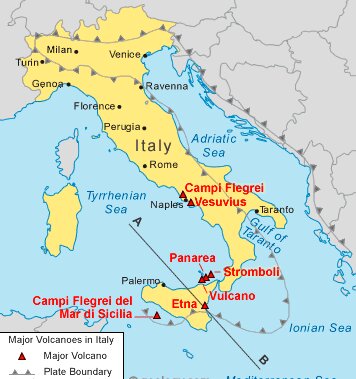Geography
Eruption on Mount Etna
- 29 Jul 2019
- 3 min read
Recently, Mount Etna in Sicily (Italy) has erupted. It spewed a plume of ash and lava as two fractures opened at the base of its crater (a bowl-shaped depression, or hollowed-out area, produced by the impact of volcanic activity).
- Eruptions of Etna follow a variety of patterns. Most occur at the summit, where there are currently (as of 2019) five distinct craters.
- Other eruptions occur on the flanks, which have more than 300 vents, ranging in size from small holes in the ground to large craters hundreds of metres across.
Mount Etna
- Mount Etna is the highest Mediterranean island mountain and the most active stratovolcano in the world. It is about 3,326 metres high and is the highest peak in Italy South of the Alps.
- The eruptive history of the volcano can be traced back 500,000 years and at least 2,700 years of this activity has been documented.
- The almost continuous eruptive activity of Mount Etna continues to influence volcanology, geophysics and other Earth science disciplines.
- The volcano also supports important terrestrial ecosystems including endemic flora and fauna and its activity makes it a natural laboratory for the study of ecological and biological processes.
Volcano
- A volcano is an opening on the surface of a planet or moon that allows material warmer than its surroundings to escape from its interior.
- When this material escapes, it causes an eruption. An eruption can be explosive, sending material high into the sky. Or it can be calmer, with gentle flows of material.
On Earth, the erupted material can be liquid rock ("lava" when it's on the surface, "magma" when it's underground), ash, cinders, and/or gas. There are three reasons why magma might rise and cause eruptions onto Earth’s surface -
- Magma can rise when pieces of Earth's crust called tectonic plates slowly move away from each other. The magma rises up to fill in the space. When this happens underwater volcanoes can form.
- Magma also rises when these tectonic plates move toward each other. When this happens, part of Earth's crust can be forced deep into its interior. The high heat and pressure cause the crust to melt and rise as magma.
- A final way that magma rises is over hot spots. Hot spots are the hot areas inside of Earth. These areas heat up magma. The magma becomes less dense. When it is less dense it rises. Each of the reasons for rising magma are a bit different, but each can form volcanoes.






-min.jpg)